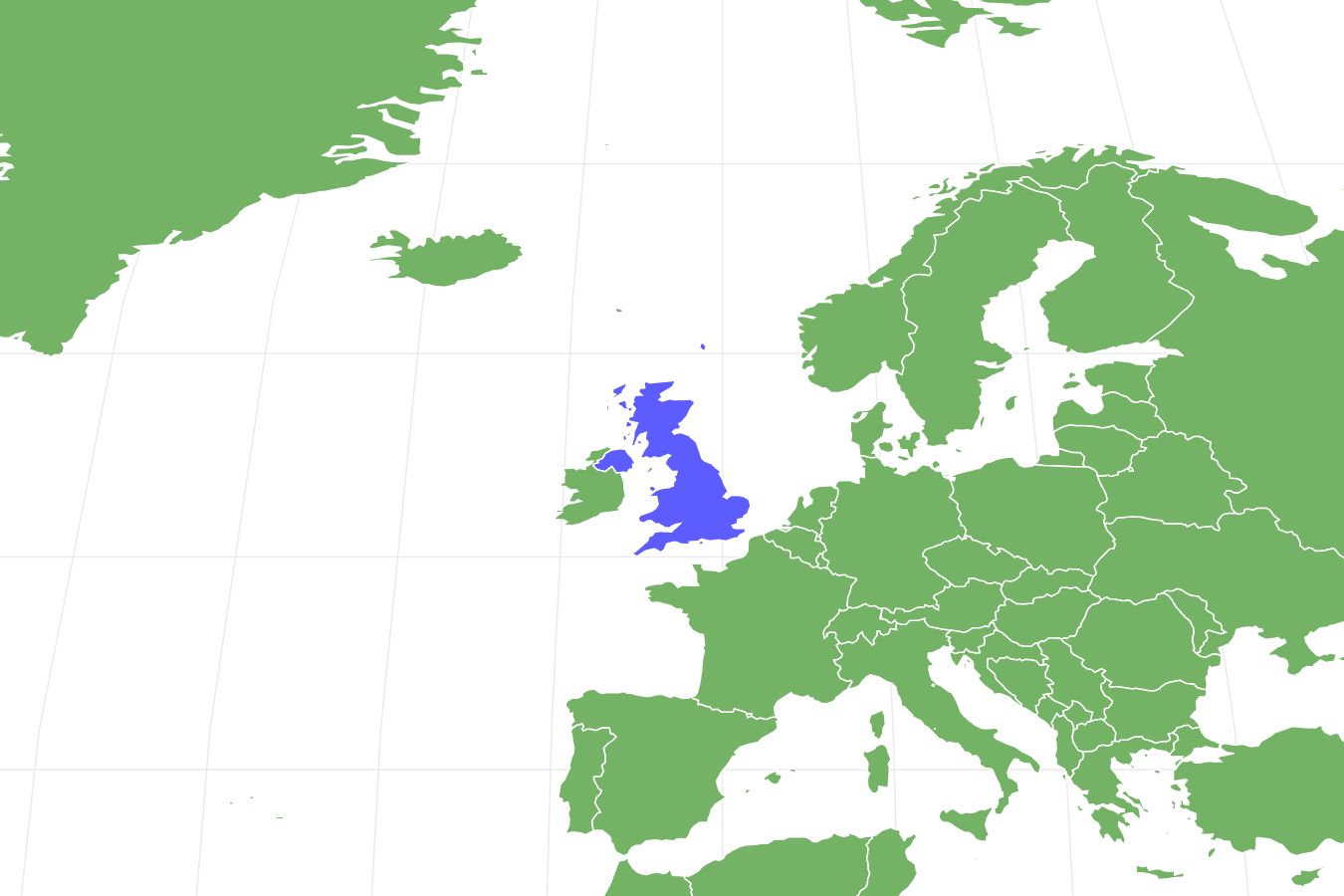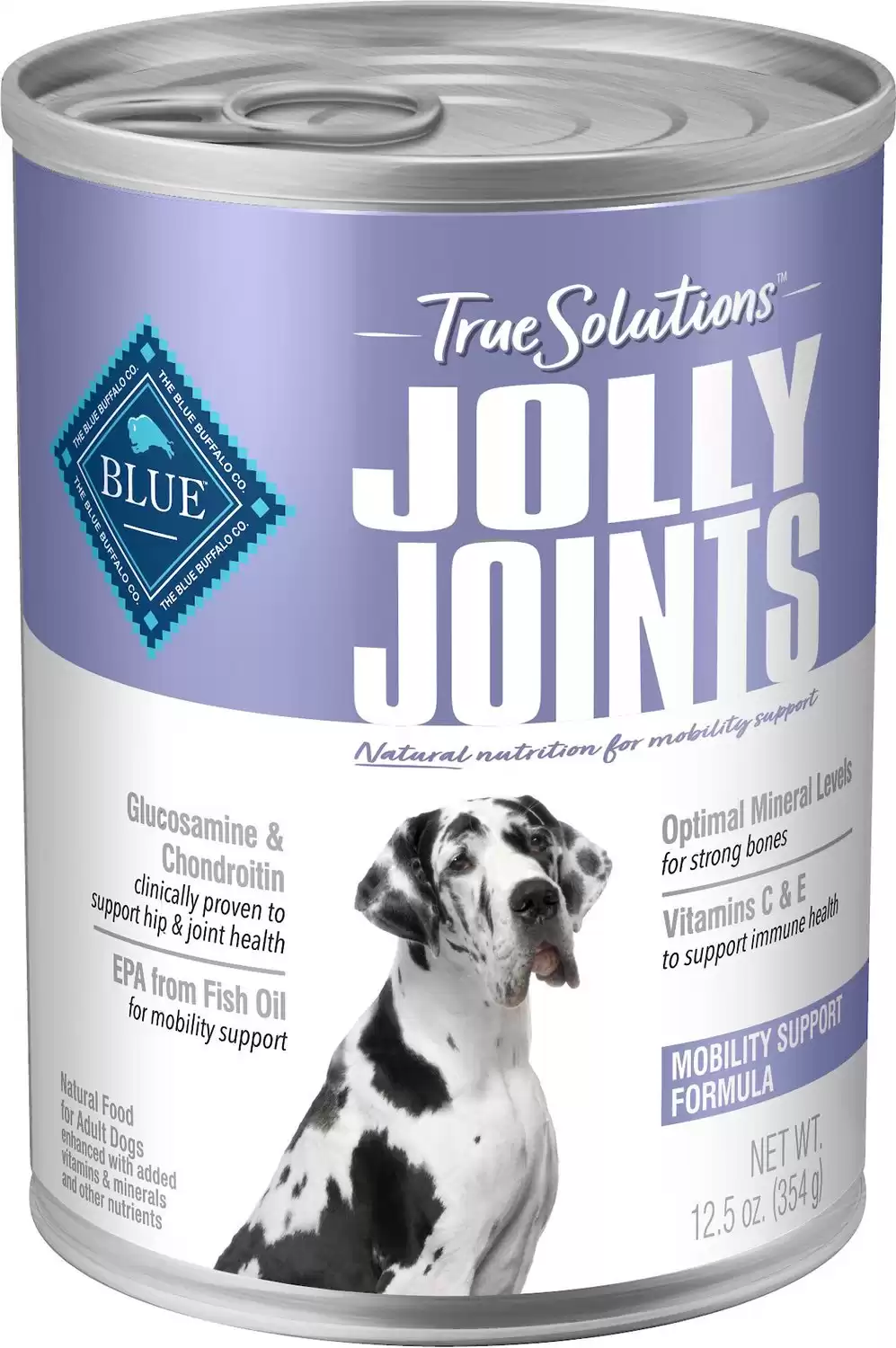Cavalier King Charles Spaniel
Canis Lupus
The Cavalier King Charles spaniel was heavily interbred with the pug and Japanese chin to the point where its appearance became virtually unrecognizable. A contest sponsored by American aristocrat Roswell Eldridge in the 1920s led to the resurgence of the breed in its original form, and the Cavalier portion of the name was added at this time to reflect its origins.
Advertisement
Cavalier King Charles Spaniel Scientific Classification
- Kingdom
- Animalia
- Phylum
- Chordata
- Class
- Mammalia
- Order
- Carnivora
- Family
- Canidae
- Genus
- Canis
- Scientific Name
- Canis Lupus
Read our Complete Guide to Classification of Animals.
Cavalier King Charles Spaniel Conservation Status
Cavalier King Charles Spaniel Facts
- Fun Fact
- The Cavalier King Charles spaniel was heavily interbred with the pug and Japanese chin to the point where its appearance became virtually unrecognizable. A contest sponsored by American aristocrat Roswell Eldridge in the 1920s led to the resurgence of the breed in its original form, and the Cavalier portion of the name was added at this time to reflect its origins.
- Diet
- Omnivore
- Common Name
- Cavalier King Charles Spaniel
Cavalier King Charles Spaniel as a Pet:
- General Health
- Energy Level
- Shedability
- Trainability
- Intelligence
- Tendency to Chew
- Size
- Family and kid friendliness
- Yappiness / Barking
- Moderate
- Separation Anxiety
- High
- Preferred Temperature
- Average climate
- Exercise Needs
- Moderate
- Friendly With Other Dogs
- High
- Pure bred cost to own
- $20,000-$30,000 lifetime
- Dog group
- Toy
- Male weight
- 13-18 lbs
- Female weight
- 13-18 lbs
This post may contain affiliate links to our partners like Chewy, Amazon, and others. Purchasing through these helps us further the A-Z Animals mission to educate about the world's species.
View all of the Cavalier King Charles Spaniel images!
Popularized by King Charles I and his son, Charles II, this toy group canine is small in stature at no taller than 13 inches, but it makes up for it with boundless affection and an insatiable desire to please.
The Cavalier King Charles spaniel was a favorite of European nobility from at least the 14th century. Originally believed to be introduced to Scotland by the French, Mary Queen of Scots brought them to England where they quickly gained attention.
Eventually popularized by King Charles I and his son Charles II, this toy group canine is small in stature. However, it makes up for it with its boundless affection. Bred from hunting spaniels and a distinct breed from King Charles Spaniels, this variety of spaniels retains its forebears’ scenting and athletic traits.
Four distinctive colors are recognized for the breed: Blenheim, ruby, tricolor, and black and tan.
At home both on the couch and competing in a variety of events, the Cavalier has an agreeable temperament. It makes for a wonderful family pet. Regal, loyal, and graceful, the Cavalier’s noble stature is a visual representation of its history and breeding.
The 10th most popular breed in the UK and 18th in the US, this spaniel comes at a high price if purchased with papers, However, numerous rescues exist for both Cavalier puppies and adults.
See all of our expert product reviews.

Evolution
Little lapdogs have been beloved status symbols for European royalty since the Renaissance. Two 17th-century Kings – Charles I and his son, Charles II, favored a black and tan spaniel that was eventually named in their honor. Some said that King Charles II was more concerned with breeding spaniels than ruling Great Britain! This love of little spaniels continued into the 19th century – when aristocrats from all over Europe bred spaniels to their liking. A breed of red and white spaniels was produced at Blenheim Palace. During Queen Victoria’s time – spaniels were bred with pugs and Japanese Chin – now known as the English Toy Spaniel or King Charles Spaniel. Because of the pug influence, these spaniels evolved a flatter face than the dogs of King Charles’s era.
Spaniel lovers of the 1920s wanted dogs that looked like the ones depicted in the paintings of the 17th century – and sought breeders who could reverse the changes. After a sizable prize was offered by the American aristocrat, Roswell Eldridge, the British breeders rose to the challenge and produced what we now know as the Cavalier King Charles spaniel.
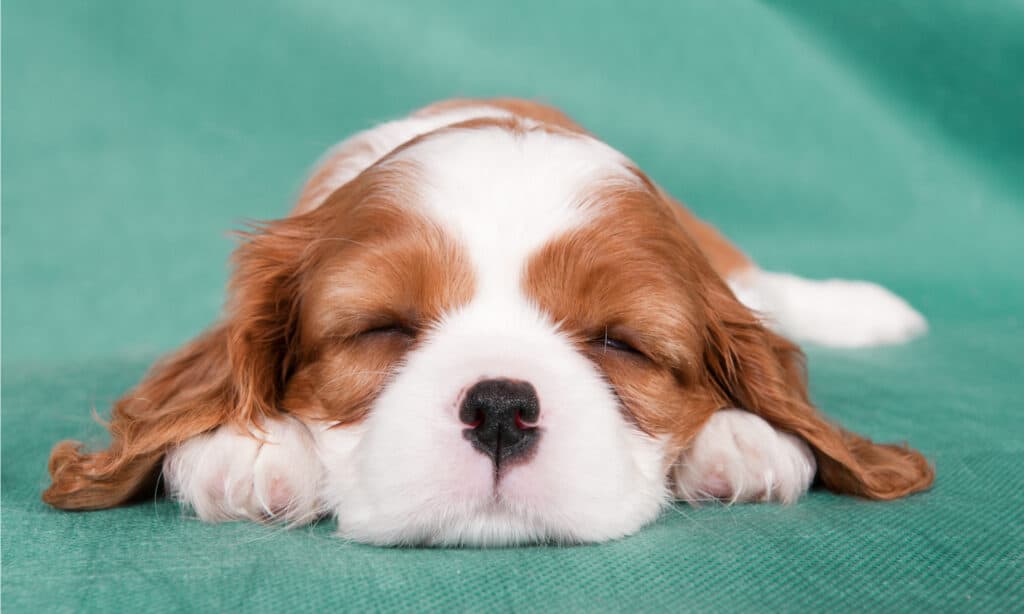
Cavalier King Charles spaniels are adaptable to both active lifestyles and apartment living.
©Tatiana Gass/Shutterstock.com
3 Pros and Cons of Owning a Cavalier King Charles Spaniel
| Pros! | Cons! |
| Highly intelligent and easy to train | Several health concerns are common with the breed |
| Social and comfortable with strangers, children, and dogs of other breeds | Prone to being overweight so the diet should be monitored |
| Adaptable to both active lifestyles and apartment living | The long coat may develop an odor if not groomed |
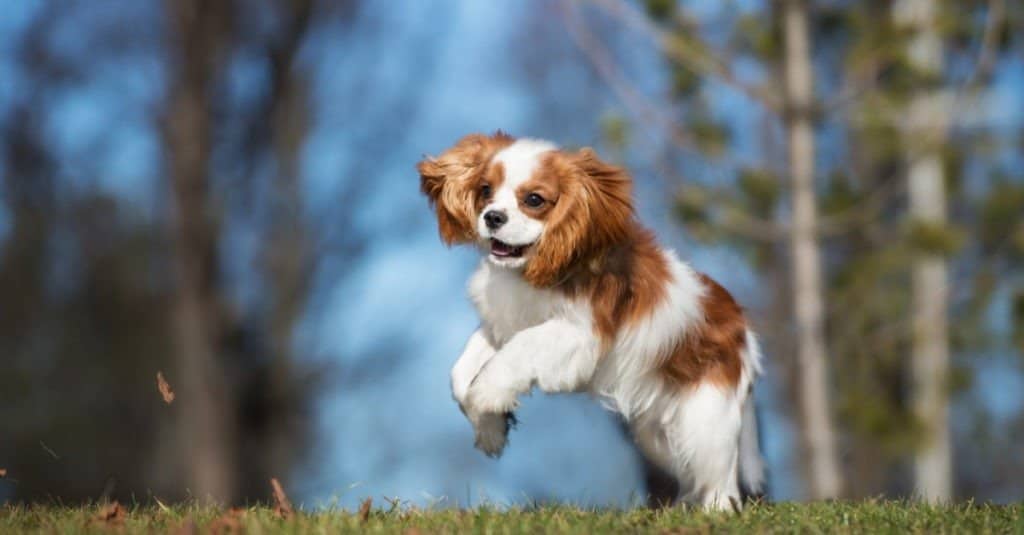
Cavaliers were bred to be lap dogs but they still retain the hunting abilities of their ancestors.
Health and Entertainment for your Cavalier King Charles Spaniel
- The Best Wet Food for Senior Dogs
- The Best Dog Food for Labrador Retrievers (Senior, Puppy, and Adult)
- These Are the Best Probiotics for Dogs (They Actually Work)
- Victor Senior Healthy Weight Dog Food Review: Recalls, Pros, Cons, and More
- The Best Dog Food for Small Dogs (Puppy, Adult, Senior): Ranked and Reviewed
See all of our expert product reviews.
©otsphoto/Shutterstock.com
Size and Weight
Per American Kennel Club (AKC) standards, the Cavalier King Charles spaniel can’t be taller than 13 inches and ranges in weight from 13-18 pounds. These ranges may vary slightly for non-show animals.
Some Common Health Issues
There are a number of health issues that are common to the Cavalier King Charles spaniel. Eye conditions like cataracts and degenerative retina issues negatively affect their vision. Hip dysplasia and kneecap issues are the most frequently occurring orthopedic complaints of this dog; hip dysplasia affects the function and mobility of the hip joint, and patella luxation is the tendency for the kneecap to move out of place.
Syringomelia is a neurological condition that results from the cerebrospinal fluid being forced through an opening into the spinal cord that is too small. It is both hereditary, progressive, and present in the Cavalier King Charles Spaniel.
Reputable breeders should test all breeding stock for any of these conditions, and many breeders also include testing for their puppies to screen for common health problems. To review, the most common health problems for this breed are:
- Cataracts and retina problems
- Hip dysplasia
- Luxating patella
- Syringomelia
Temperament
The Cavalier King Charles spaniel is an extremely versatile pet. While they were bred as lapdogs and have the associated calm and loving personality, they also retain the scenting and hunting behaviors of their ancestors. They perform well in a number of canine sports such as agility, rally, and obedience. Yet they also enjoy living the couch potato life. It is really all based on the personality of their owner.
This breed is highly intelligent and easily trainable. You should capitalize on this by starting training early. This will help to prevent separation anxiety should they need to be left alone regularly for any length of time. The insatiable desire to please propels this dog breed to success, and it is a hallmark trait of the breed.
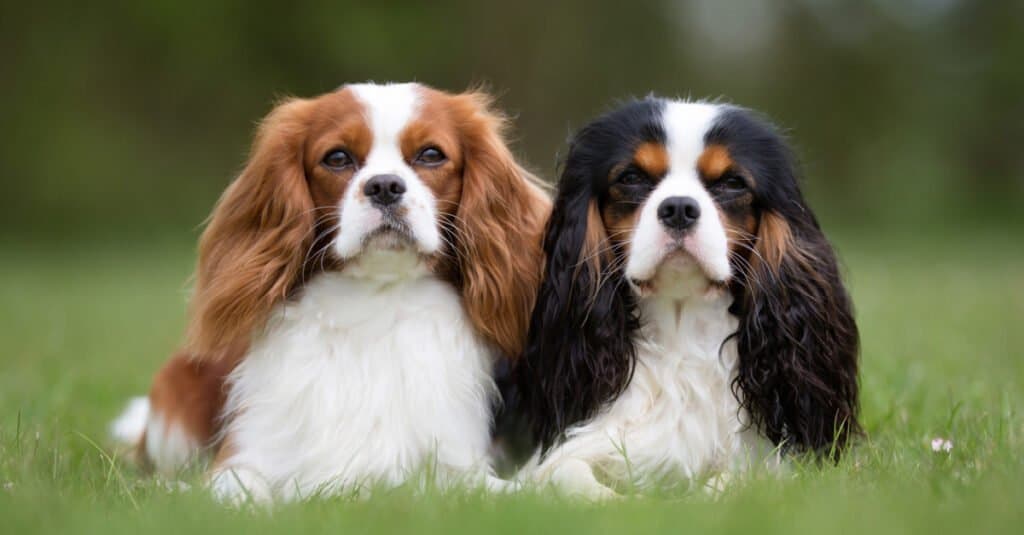
The Cavalier King Charles spaniel is a very loving and loyal dog.
©BIGANDT.COM/Shutterstock.com
How to Take Care of Cavalier King Charles Spaniel
Caring for a Cavalier King Charles spaniel entails a wide range of considerations. This holds true for both puppies and more senior dogs. These pets will lead a happy and healthy life if you stick to these best practices.
The Best Dog Food for Cavalier King Charles Spaniels
Just as human nutritional needs change as they age, so too do the dietary requirements of the Cavalier King Charles spaniel. Due to the potential for orthopedic issues like hip dysplasia, dog food high in calcium or appropriate dietary supplements are especially beneficial for puppies. Care should be taken to avoid foods that are high in carbohydrates particularly if your dog leads a more sedentary lifestyle as this breed has a tendency towards obesity.
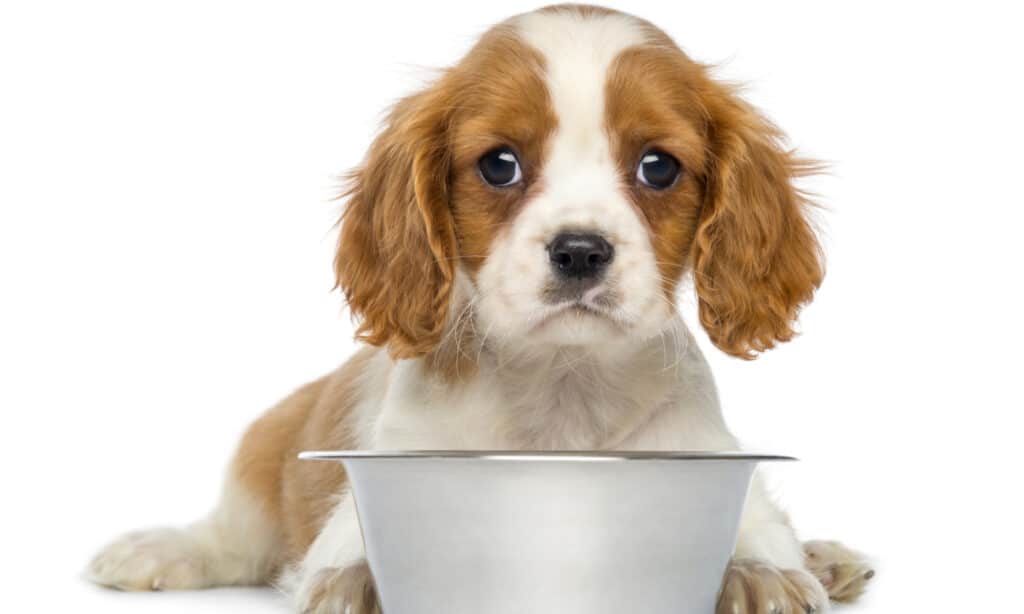
Cavalier King Charles spaniels need to eat measured portions of high-quality food to prevent obesity.
©Eric Isselee/Shutterstock.com
For adults, calcium supplementation may still be beneficial, but you should discuss that with your veterinarian. Next to freshly prepared options, canned, high-quality dog food typically provides the best mix of nutrients while limiting carbohydrates. Weight control is even more of a concern as these toy dog’s age because obesity only exacerbates any orthopedic issues that may already be present.
At A-Z Animals, we think a good food for Cavalier King Charles Spaniels is Blue Buffalo True Solutions Jolly Joints Natural Mobility Support Adult Wet Dog Food.
This joint-nourishing food is full of natural ingredients offering chondroitin and glucosamine to combat hip dysplasia and patellar luxation. It has EPA, vitamins C and E, with vitamin A and taurine for your Cavalier King Charles Spaniels’ bones, eyes, and heart. Plus, feeding this breed wet food may help these dogs stay at a healthy weight.
Find Blue Buffalo True Solutions Jolly Joints on Chewy or Amazon.
- Glucosamine and chondroitin support healthy hips and joints, EPA from fish oil encourages healthy mobility and minerals promote strong bones.
- Crafted with natural ingredients and enhanced with vitamins, minerals and other nutrients.
- Made with real chicken as the very first ingredient, followed by fruits and veggies to naturally support mobility.
- Wheat-free recipe made without chicken (or poultry) by-product meals or other common food allergens like corn, wheat or soy.
- 100% free from artificial flavors and preservatives.
Maintenance and Grooming
The long hair of this spaniel needs to be regularly brushed in order to prevent the collection of debris that can create unpleasant odors. This also helps to reduce any shedding. Proper care of the coat of your Cavalier will go a long way to ensuring its luscious shine remains. Ruby, tricolor, Blenheim, and black and tan spaniels all look their best when properly groomed.
Aside from monthly baths and nail trimmings, regular brushing is the extent of the maintenance and grooming requirement for this breed. Overall, it is a relatively low-maintenance dog, and no special tools are required beyond a brush and nail trimmer.
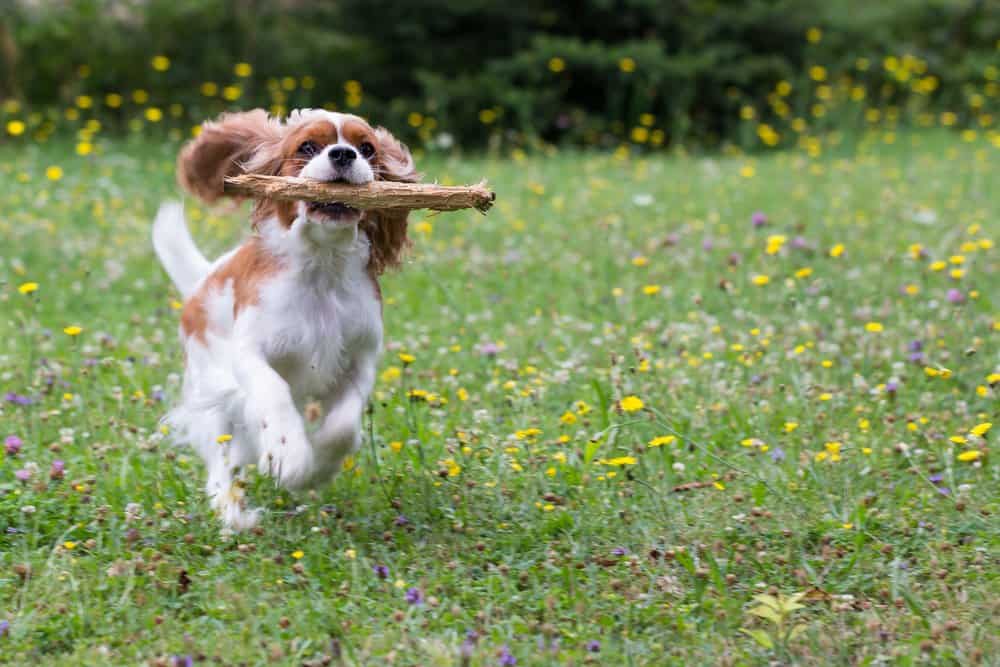
Cavalier King Charles spaniels love to run and play and are easy to train.
©Martin Mehes/Shutterstock.com
Training
These dogs are so bright that training is typically very easy. Their high drive to please their owner coupled with some positive reinforcement is all that you should need to accomplish even a high degree of obedience training.
Socialization and preventative training for separation (should it be necessary) must be addressed early on in the puppy stage for the highest degree of success. Cavaliers adopted from rescues may need a slightly different approach due to unknown circumstances prior to adoption.
Exercise
A daily walk of moderate length is all that is necessary to make sure that your spaniel is properly exercised and healthy. While they are content to be lapdogs and even thrive in apartment living, regular exercise is good for your Cavalier.
Due to their hunting dog ancestry, these pups may not heed their owner’s commands if they catch an interesting scent. It is critical that they never be allowed off-leash or in an unfenced yard for this very reason.
These dogs can also adapt to much more exercise, and the breed is a regular competitor in several canine sports. Their go-with-the-flow temperament allows them to conform to whatever lifestyle their owner leads.
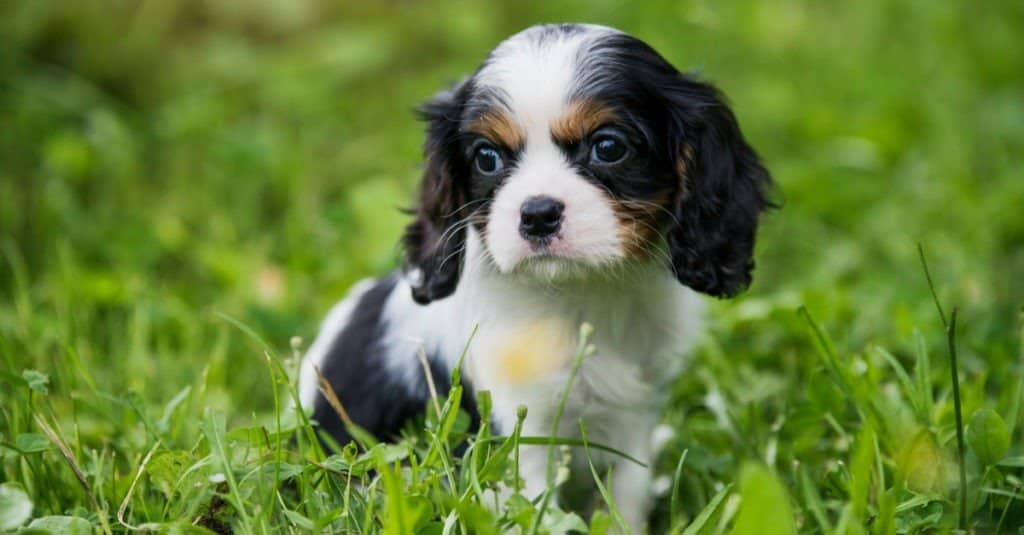
Cavalier puppies thrive on affection and are great with children.
©Ssilverartist/Shutterstock.com
Puppies
There are no special considerations for puppies of this breed over any normal puppy care instructions. Regular checkups, appropriate nutrition, and standard training are the name of the game.
Children and Cavaliers are a Match Made in Heaven
Children and this breed are a match made in heaven. They thrive on affection and are huge fans of snuggling. The most important concern is that children have the appropriate knowledge of how to behave around any dog breed. The same traits that make this dog a wonderful therapy dog also make it great for life with children. Learn more about the best dog breeds for families with children here.
Dogs Similar to Cavalier King Charles Spaniel
Dog breeds similar to this spaniel are the English cocker spaniel, the pug, and the Japanese chin.
- English cocker spaniel – This sporting dog breed is an ancestor of the Cavalier King Charles spaniel and bears similar colors. It is the source of the breed’s hunting instincts and high drives.
- Pug – The Pug is another loving homebody. They are much more strong-willed and have myriad more health concerns when compared to the English King Charles spaniel. Their short coat requires less maintenance and is less prone to shedding as well.
- Japanese chin – The Japanese equivalent of the English King Charles spaniel is the Japanese chin. Bred to be loving lapdogs, these canines were a favorite of high-class Japanese citizens. In colors and hair, they bear a strong similarity to the English King Charles spaniel, but they have a flatter face and pronounced eyes like a pug.

Cavaliers will be happy to go anywhere with you!
©Page Light Studios/Shutterstock.com
Famous Cavalier King Charles Spaniel
Arguably, the most famous King Charles spaniel is Rex who belonged to Mary Queen of Scots. She was beheaded with Rex beneath her skirts, and it is rumored that he refused to leave her body until he died from grief several days later.
Although not technically a Cavalier as that is a moniker given to the renewed breed of the 20th century, Rex’s story makes him more than worthy of his fame. President Ronald Reagan also owned a Blenheim Cavalier King Charles spaniel named Rex!
Popular Names for Cavalier King Charles Spaniel
Popular names for Cavalier King Charles spaniels are:
- Blenheim
- Rex
- Tudor
- Ruby
- Bella
- Trixie
- Violet
- Rusty
Cavalier King Charles Spaniel FAQs (Frequently Asked Questions)
Are Cavalier King Charles Spaniels herbivores, carnivores, or omnivores?
Cavalier King Charles Spaniels are Omnivores, meaning they eat both plants and other animals.
What Kingdom do Cavalier King Charles Spaniels belong to?
Cavalier King Charles Spaniels belong to the Kingdom Animalia.
What class do Cavalier King Charles Spaniels belong to?
Cavalier King Charles Spaniels belong to the class Mammalia.
What phylum to Cavalier King Charles Spaniels belong to?
Cavalier King Charles Spaniels belong to the phylum Chordata.
What family do Cavalier King Charles Spaniels belong to?
Cavalier King Charles Spaniels belong to the family Canidae.
What order do Cavalier King Charles Spaniels belong to?
Cavalier King Charles Spaniels belong to the order Carnivora.
What genus do Cavalier King Charles Spaniels belong to?
Cavalier King Charles Spaniels belong to the genus Canis.
What type of covering do Cavalier King Charles Spaniels have?
Cavalier King Charles Spaniels are covered in Hair.
What is an interesting fact about Cavalier King Charles Spaniels?
Cavalier King Charles Spaniels are highly playful and affectionate!
What is the scientific name for the Cavalier King Charles Spaniel?
The scientific name for the Cavalier King Charles Spaniel is Canis Lupus.
What is the lifespan of a Cavalier King Charles Spaniel?
Cavalier King Charles Spaniels can live for 15 years.
How much is a Cavalier King Charles Spaniel?
Puppies from AKC certified breeders can range from $2,500-$5,000 in price depending on parentage and a number of other factors. Rescues and adult spaniels are typically much cheaper; however, this can also vary if the adult dog has papers or a showing history. Depending on initial adoption costs, you can expect to pay $20,000-$30,000 over the course of your Cavalier’s 12-15 year life.
How big is a Cavalier King Charles Spaniel?
The Cavalier King Charles spaniel is a toy breed. As such, it is one of the smaller dogs weighing in at 13-18 pounds and standing no higher than 13 inches.
Do Cavalier King Charles spaniels bark a lot?
Generally speaking, they are only moderate barkers. They do have a tendency to suffer from separation anxiety due to their high levels of attachment, and this can lead to excessive barking and yelping when left alone for long periods of time.
Are Cavalier King Charles spaniels good family pet?
Yes! Actually, these toy dogs make phenomenal family pets. This is all a result of their intentional breeding. Bred for use as a lapdog for nobility, the Cavalier King Charles spaniel is calm, loving, affectionate, and will bond with all members of the family from children to other dogs.
Are Cavalier King Charles spaniels good with kids?
Absolutely. This breed thrives on affection and will love your children as much as you do. This loving demeanor makes the Cavalier well worth the price.
Can Cavalier King Charles spaniels be left alone?
Separation anxiety is a real concern for this breed. They can be left alone, but without adequate preparation as a puppy the Cavalier King Charles spaniel is prone to excessive barking, chewing, and other similar behaviors.
What are the differences between the American Cocker Spaniel and the Cavalier King Charles Spaniel?
The differences between the American Cocker Spaniel and the Cavalier King Charles Spaniel include size, appearance, breeding group, behavior, health problems, and lifespan.
Thank you for reading! Have some feedback for us? Contact the AZ Animals editorial team.
Sources
- akc.org, Available here: https://www.akc.org/dog-breeds/cavalier-king-charles-spaniel/
- marketplace.akc.org, Available here: https://marketplace.akc.org/puppies/cavalier-king-charles-spaniel?breed=72&page=7
- hellobark.com, Available here: https://hellobark.com/dogs/cavalier-king-charles-spaniel-hypoallergenic/
- hellobark.com, Available here: https://hellobark.com/dogs/cavalier-king-charles-spaniel-separation-anxiety/
- ckcsc.org, Available here: https://ckcsc.org/syringomyelia
- l-love-cavaliers.com, Available here: https://i-love-cavaliers.com/the-cavalier-breed/famous-cavalier-king-charles-spaniels/
- theantiquealmanac.com, Available here: http://theantiquesalmanac.com/thosecharmingstaffordshiredogs.htm

